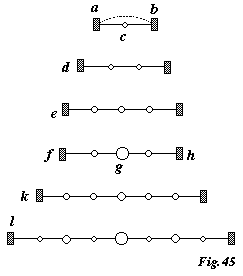CONSTRUCTION XVII. FILLING OF APERTURE 223
The window-bars must, therefore, be of stone, and of stone only.
§ 5. The purpose of the window being always to let in as much light, and command as much view, as possible, these bars of stones are to be made as slender and as few as they can be, consistently with their due strength.
Let it be required to support the breadth of glass, a b, Fig. 45. The tendency of the glass sustaining any force, as of wind from without, is to bend into an arch inwards, in the dotted line, and break 
But this central bar, c, may not be enough, and the spaces a c, c b, may still need support. The next step will be to put two bars instead of one, and divide the window into three spaces, as at d.
But this may still not be enough, and the window may need three bars. Now the greatest stress is always on the centre of the window. If the three bars are equal in strength, as at e, the central bar is either too slight for its work, or the lateral bars too thick for theirs. Therefore, we must slightly increase the thickness of the central bar, and diminish that of the lateral ones, so as to obtain the arrangement at f h. If the window enlarge farther, each of the spaces f g, g h, is treated as the original space a b, and we have the groups of bars k and l.
So that, whatever the shape of the window, whatever the direction and number of the bars, there are to be central or main bars; second bars subordinated to them; third bars subordinated to the second, and so on to the number required. This is called the subordination of tracery, a system delightful to the eye and mind, owing to its anatomical framing and unity, and to its expression of the laws of good
[Version 0.04: March 2008]